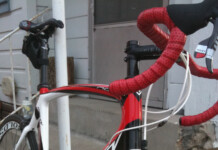By Tom Jow, From our Fall/Winter 2011 Issue
Every sport has specialized clothing needs and cycling is no different. Unlike a sport like indoor swimming where conditions are constant, conditions while riding can change minute to minute. What makes cycling clothing unique is the ability to perform many tasks at once. Specifically, cool weather bicycling clothes must be able to insulate, ventilate and protect, all while being able to stow easily in a pocket or hydration pack. Whether you plan to participate in the cyclocross races, stay out of spin classes as long as possible or just plain want to keep riding outside, you will need to have a selection of clothing available for a variety of conditions.
For the first level of cool weather, arm, knee and leg warmers are an absolute necessary of any cyclist’s kit. This accessory, covering just what they describe, insulate the extremities with the ease of ventilation by rolling them up or down. Also, they can be easily removed and stashed in a pocket or pack. Another fall essential is a lightweight wind jacket or vest, especially when riding in the mountains. Not only can the weather change quickly, but descending after a long climb can easily produce a chill. Even on a cold, cold day it is easy to get hot and sweaty on a long climb, so it is important to have a wind wear that can fit in a pocket on the way up.
When it gets a little colder, we will need to insulate more. At this point we are just beginning to think it is cold so remember, if you are not a little chilled when you start, you’ll be overheated in about 15 min. In this range a long sleeve jersey with a long or full zipper works well. Size your long sleeve jerseys with a base layer in mind. Also, the fingers and toes will need more protection. A pair of lightly insulated, windproof gloves and toe covers (a stretchy, fleecy cap covering, you got it, just the toes!) keep the digits warm. Depending on the rider, changing leg warmers for full length tights may also be necessary at this point.
If you continue riding into a colder temperature range, blocking the wind as well as protecting the fingers and toes become a priority. Keep in mind that on a windless day, as soon as the cyclist begins pedaling there is wind (ever wonder why there’s always a head wind).Wind chill increases exponentially with speed and can quickly suck the heat out of an unprepared rider. Special insulated gloves called “lobster” mitts (they look like lobster claws) have the fingers split into pairs to keep them warm and allow use of the shifters and brakes. Fleece lined shoe covers called “booties” fit over the shoes and have a cut out for the pedal cleat. Also, we probably need wind front tights now. Specifically for winter riding, these tights have a windproof (sometimes waterproof) material in front and breathable insulation on the back. Remember to keep the head warm too. Up to 30 percent of the body’s heat loss escapes from the head. A thermal hat or skull cap under the helmet goes a long way to keeping the rider warm. If you are out riding now you are pretty serious.
At temperatures below freezing you are hardcore. Now we want to minimize the amount of skin that is exposed to wind, rain or snow. A balaclava is the ticket to keeping the face and neck warm. Staying dry in the rain and snow is an important factor in cycling comfort but even more so at this level. Coated nylon jackets with vents and pit zips work well in the rain if the exertion level is not too high. Gore-Tex, although breathable, also needs good ventilation ( i.e. zippers, vents) to work well for high output riding. Newer soft-shell fabrics are highly breathable and water resistant. Outerwear made with these fabrics will work well in light rain and snow.Add to this a water proof helmet cover and you will be ready for anything.
Riding in the snow and rain is not something a lot of people are going to do everyday. But those that do ride in winter have found it to be pretty simple and enjoyable after developing a system for one level of cold, and then building upon it for the next. Some riders even welcome the challenge to be motivated and determined to ride in all conditions. At this point in my career, I may just take up swimming instead.
Cool Weather ( 50* +)
Arm, Knee and/or Leg Warmers
Wind-front Vest
Lightweight, Packable Wind Jacket
Long Finger Gloves
Cold Weather ( 40*-50*)
Lightweight Insulated Gloves
Toe Covers
Thermal Tights
Long Sleeve Jersey w/ Zip (long or full)
Lightweight Base Layer
Colder Weather ( 30*-40*)
Insulated Gloves of Mitts
Full Length Booties
Wind Front Tights
Under Helmet Skull Cap or Hat








Great article on Winter Clothing but I think I will stay inside when it goes below 50*.
I still have about 160 miles to get my Goal of 2500 miles this year. So I will do it on my Trainer or Schwinn Air-Dyne.
Keep up the good work.
Frank Roskelley
Comments are closed.